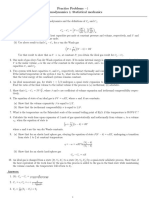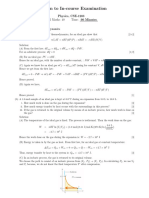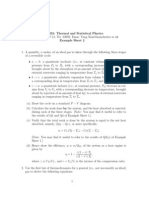0 ratings0% found this document useful (0 votes)
6 views16 - 7-PDF - Thermodynamics (Red Book) 2
16 - 7-PDF - Thermodynamics (Red Book) 2
Uploaded by
PranayThe document discusses molar heat capacities at constant volume (Cv) and constant pressure (Cp). It defines Cv as the heat required to raise 1 mole of a gas by 10°C at constant volume. It then derives that Cp - Cv = R, showing that for an ideal gas, Cp is greater than Cv by the amount of the gas constant R due to the additional work done when heating at constant pressure rather than constant volume.
Copyright:
© All Rights Reserved
Available Formats
Download as PDF, TXT or read online from Scribd
16 - 7-PDF - Thermodynamics (Red Book) 2
16 - 7-PDF - Thermodynamics (Red Book) 2
Uploaded by
Pranay0 ratings0% found this document useful (0 votes)
6 views1 pageThe document discusses molar heat capacities at constant volume (Cv) and constant pressure (Cp). It defines Cv as the heat required to raise 1 mole of a gas by 10°C at constant volume. It then derives that Cp - Cv = R, showing that for an ideal gas, Cp is greater than Cv by the amount of the gas constant R due to the additional work done when heating at constant pressure rather than constant volume.
Original Description:
brain+rules+filetype:pdf
Original Title
16_7-PDF_THERMODYNAMICS (RED BOOK)2 (3)
Copyright
© © All Rights Reserved
Available Formats
PDF, TXT or read online from Scribd
Share this document
Did you find this document useful?
Is this content inappropriate?
The document discusses molar heat capacities at constant volume (Cv) and constant pressure (Cp). It defines Cv as the heat required to raise 1 mole of a gas by 10°C at constant volume. It then derives that Cp - Cv = R, showing that for an ideal gas, Cp is greater than Cv by the amount of the gas constant R due to the additional work done when heating at constant pressure rather than constant volume.
Copyright:
© All Rights Reserved
Available Formats
Download as PDF, TXT or read online from Scribd
Download as pdf or txt
0 ratings0% found this document useful (0 votes)
6 views1 page16 - 7-PDF - Thermodynamics (Red Book) 2
16 - 7-PDF - Thermodynamics (Red Book) 2
Uploaded by
PranayThe document discusses molar heat capacities at constant volume (Cv) and constant pressure (Cp). It defines Cv as the heat required to raise 1 mole of a gas by 10°C at constant volume. It then derives that Cp - Cv = R, showing that for an ideal gas, Cp is greater than Cv by the amount of the gas constant R due to the additional work done when heating at constant pressure rather than constant volume.
Copyright:
© All Rights Reserved
Available Formats
Download as PDF, TXT or read online from Scribd
Download as pdf or txt
You are on page 1of 1
PROF.
RAKESH RATHI’S CHEMISTRY TUTORIALS
Molar Heat Capacity at constant volume: It is defined as the amount of heat required to raise the temperature
of 1 mole of a gas by 10C or 1K at constant volume.
Represented as Cv.
Given by:
dq
Cv =
dT v
dU
But at constant volume, dq = dU Cv =
dT v
Derive Cp - Cv = R OR show that : Cp > Cv
Show that the difference in molar heat capacities at constant pressure and at constant volume of a gas is
equal to the gas constant.
The enthalpy of 1 mole of an ideal gas is given by
H = U + PV
Differentiating the equation with respect to temperature at constant pressure.
dH = dU P dV
dT dT dT
By definitions, Cp - molar heat capacity at constant Pressure
Cv - molar heat capacity at constant Volume
Cp = dH / dT and Cv = dU /dT,
Cp = Cv + P dV/ dT ......(1)
For 1 mole of an ideal gas:
PV = RT
Where R is a gas constant.
Differentiating with respect to 'T' at Constant Pressure,
d(PV) = R d(T)
dT dT
P dV = R
dT
Substituting in equation (1)
Cp = Cv + R
Cp - Cv = R
Thus Cp > Cv by the amount of work done when 1 mole of an ideal gas is heated by 1K = R
16
You might also like
- Practice Problems 1 Thermodynamics & Statistical MechanicsDocument2 pagesPractice Problems 1 Thermodynamics & Statistical MechanicsRandeep Iyyad N CNo ratings yet
- Ideal Gas LawDocument21 pagesIdeal Gas Lawjervis GrajoNo ratings yet
- EU2-Chap 4Document2 pagesEU2-Chap 4Kevin Mark IlaganNo ratings yet
- Aula 5Document46 pagesAula 5hannibal_12No ratings yet
- Unit 2 Gas Laws and Power CyclesDocument103 pagesUnit 2 Gas Laws and Power CyclesNishad BhavsarNo ratings yet
- Lecture 2: Enthalpy: - Reading: Zumdahl 9.2, 9.3 - OutlineDocument18 pagesLecture 2: Enthalpy: - Reading: Zumdahl 9.2, 9.3 - Outlinesyahrial_chaniago4769No ratings yet
- The First Law of Thermodynamics (CHAP. 4Document5 pagesThe First Law of Thermodynamics (CHAP. 4mozam haqNo ratings yet
- Ideal Gas LawDocument17 pagesIdeal Gas LawSandra AbancioNo ratings yet
- Ideal Gas LecDocument20 pagesIdeal Gas LeckarluiscinensepogiNo ratings yet
- Thermodynamics of Dry AirDocument46 pagesThermodynamics of Dry AirAwatif MaisaraNo ratings yet
- Lecture 4Document46 pagesLecture 4abode-m-rNo ratings yet
- Week 6Document4 pagesWeek 6brannmacleinNo ratings yet
- Chemical Thermodynamics Chap 2Document13 pagesChemical Thermodynamics Chap 2Julio JohnsonNo ratings yet
- Thermodynamics+Lecture 2+Document250 pagesThermodynamics+Lecture 2+Ridham GuptaNo ratings yet
- Property Table From Direct Measurement Equation of State Any Equations That Relates P, V, and T of A SubstanceDocument52 pagesProperty Table From Direct Measurement Equation of State Any Equations That Relates P, V, and T of A SubstanceKamran Mostajiri100% (1)
- ThermodynamicsDocument7 pagesThermodynamicsdhonisingh437No ratings yet
- Chapter 3 560982adad40bDocument5 pagesChapter 3 560982adad40bJimson MasculinoNo ratings yet
- Thermodynamics and Entropy Eng ItaDocument40 pagesThermodynamics and Entropy Eng ItaLeonardo RubinoNo ratings yet
- (L3) Laws of ThermodynamicsDocument42 pages(L3) Laws of Thermodynamics077bce134.sagarNo ratings yet
- Lecture 2b - 3 - Heat Capacities - Enthalpy - Hess - Online - Class - 2020Document28 pagesLecture 2b - 3 - Heat Capacities - Enthalpy - Hess - Online - Class - 2020Jey BlaQNo ratings yet
- T1 SolDocument31 pagesT1 SolEmuNo ratings yet
- Lecture 3 - Systems (SFEE) Specific Heats The Working FluidDocument38 pagesLecture 3 - Systems (SFEE) Specific Heats The Working FluidWillie MojataleNo ratings yet
- Module 3 Ideal Gases and Ideal Gas LawDocument12 pagesModule 3 Ideal Gases and Ideal Gas LawHazel AdoNo ratings yet
- Ideal Gas Model: Review, Ideal Gas Model, Ideal Gas Equation of State, Thermodynamic Properties of Ideal GasesDocument34 pagesIdeal Gas Model: Review, Ideal Gas Model, Ideal Gas Equation of State, Thermodynamic Properties of Ideal GasesJake SyNo ratings yet
- Thermodynamics IDocument8 pagesThermodynamics IFerdaus Hasan BappiNo ratings yet
- Cap 11 6edDocument94 pagesCap 11 6edmecgirls212No ratings yet
- ME 161: Introduction To Mechanical Engineering: Asif KabirDocument21 pagesME 161: Introduction To Mechanical Engineering: Asif KabirMohammad Asif KabirNo ratings yet
- The Working Fluid in ThermodynamicsDocument13 pagesThe Working Fluid in ThermodynamicsFarouk BassaNo ratings yet
- Steady Flow Energy Equation (SFEE) :) Z Z (+ G 2 C 2 C + H W H QDocument23 pagesSteady Flow Energy Equation (SFEE) :) Z Z (+ G 2 C 2 C + H W H QSams ArefinNo ratings yet
- Lecture 2 - CHE303Document19 pagesLecture 2 - CHE303Abdullah AltwirqiNo ratings yet
- Calorimetry (Theory) Module-3Document5 pagesCalorimetry (Theory) Module-3Raju SinghNo ratings yet
- Lesson Plan 7Document13 pagesLesson Plan 7khandaker raiyanNo ratings yet
- Gasdynamics AE4140 Chapter 1: IntroductionDocument60 pagesGasdynamics AE4140 Chapter 1: IntroductionPythonraptorNo ratings yet
- Physical ChemDocument57 pagesPhysical ChemDENISE COLENo ratings yet
- Heat CapacityDocument4 pagesHeat CapacityZedan MahamedNo ratings yet
- Module 5.docx ThermoDocument17 pagesModule 5.docx ThermoOyedotun TundeNo ratings yet
- Chapter 2 and 3Document40 pagesChapter 2 and 3S S S REDDYNo ratings yet
- Chapter Two ThermodynamicsDocument12 pagesChapter Two ThermodynamicsfellisdavyNo ratings yet
- phy mod 4Document116 pagesphy mod 4IIT PHYSICS BY BL KUMAWATNo ratings yet
- Physics PreparationDocument85 pagesPhysics Preparationarafatahmmed51No ratings yet
- Exam 20 SolutionDocument12 pagesExam 20 Solutionmaks.lavrentiiNo ratings yet
- ME 331 Thermodynamics II Lecture 3cDocument31 pagesME 331 Thermodynamics II Lecture 3cJosell CaipangNo ratings yet
- Phase Equillibria-VrazDocument46 pagesPhase Equillibria-VrazSindhu KemburuNo ratings yet
- Hw1phys2 2019Document3 pagesHw1phys2 2019jiddagerNo ratings yet
- Chapter8 Real Gases and Mixture of GasesDocument26 pagesChapter8 Real Gases and Mixture of GasesMUHAMMED FAISALNo ratings yet
- gas_laws_notes_2018Document2 pagesgas_laws_notes_2018amcmurtryNo ratings yet
- Volumetric PropertiesDocument36 pagesVolumetric PropertiesRohan BhilkarNo ratings yet
- Week 5Document6 pagesWeek 5brannmacleinNo ratings yet
- Thermodynamics (Part 3)Document14 pagesThermodynamics (Part 3)Yt SparkNo ratings yet
- Exercise 2Document2 pagesExercise 2heyjude0No ratings yet
- Wen FengDocument22 pagesWen Fengdueltmpotc8wNo ratings yet
- Specific Heat Capacities of GasesDocument3 pagesSpecific Heat Capacities of GasesVenu GopalNo ratings yet
- Silo - Tips - Chapter 5 The Gaseous StateDocument18 pagesSilo - Tips - Chapter 5 The Gaseous StateJerich Ivan PaalisboNo ratings yet
- PS 3Document3 pagesPS 3Shirish MaheshwariNo ratings yet
- Chapter 1 CHM476 (Part 3 and 4)Document25 pagesChapter 1 CHM476 (Part 3 and 4)PUTRI DAYANA BATRIESYA ABDUL HANIFNo ratings yet
- Physics 23 Fall 1993 Lab 2 - Adiabatic Processes: PV NRTDocument13 pagesPhysics 23 Fall 1993 Lab 2 - Adiabatic Processes: PV NRTvipul ch v v n s sNo ratings yet
- ThermodynamicsDocument22 pagesThermodynamicsSheldon KyleNo ratings yet
- Patterns: Classic Patterns vs. Modern Elliott Wave PatternsDocument1 pagePatterns: Classic Patterns vs. Modern Elliott Wave PatternsPranay0% (1)
- 1 - 7 PDF - 8536693 Elliott Wave UnveiledDocument1 page1 - 7 PDF - 8536693 Elliott Wave UnveiledPranayNo ratings yet
- 16 7 PDF 8536693 Elliott Wave UnveiledDocument1 page16 7 PDF 8536693 Elliott Wave UnveiledPranayNo ratings yet
- See The Successful Impulse Wave 1 On The AOL ChartDocument1 pageSee The Successful Impulse Wave 1 On The AOL ChartPranayNo ratings yet
- 31 - 7 PDF - 8536693 Elliott Wave UnveiledDocument1 page31 - 7 PDF - 8536693 Elliott Wave UnveiledPranayNo ratings yet
- Trends C. Diagonal Triangle Type 1: PatternDocument1 pageTrends C. Diagonal Triangle Type 1: PatternPranayNo ratings yet
- 17: History of World War I: by Albert E. Mckinley, PH.DDocument1 page17: History of World War I: by Albert E. Mckinley, PH.DPranayNo ratings yet
- 37 - 7 PDF - 8536693 Elliott Wave UnveiledDocument1 page37 - 7 PDF - 8536693 Elliott Wave UnveiledPranayNo ratings yet
- 25 - 7 PDF - 432352921 100 One Minute Speed Reading Drills by David ButlerDocument1 page25 - 7 PDF - 432352921 100 One Minute Speed Reading Drills by David ButlerPranayNo ratings yet
- 37 - 7 PDF - 432352921 100 One Minute Speed Reading Drills by David ButlerDocument1 page37 - 7 PDF - 432352921 100 One Minute Speed Reading Drills by David ButlerPranayNo ratings yet
- 34 - 7 PDF - 432352921 100 One Minute Speed Reading Drills by David ButlerDocument1 page34 - 7 PDF - 432352921 100 One Minute Speed Reading Drills by David ButlerPranayNo ratings yet
- 49 - 7 PDF - 432352921 100 One Minute Speed Reading Drills by David ButlerDocument1 page49 - 7 PDF - 432352921 100 One Minute Speed Reading Drills by David ButlerPranayNo ratings yet
- 16 - 7 PDF - 432352921 100 One Minute Speed Reading Drills by David ButlerDocument1 page16 - 7 PDF - 432352921 100 One Minute Speed Reading Drills by David ButlerPranayNo ratings yet
- 19 - 7 PDF - 432352921 100 One Minute Speed Reading Drills by David ButlerDocument1 page19 - 7 PDF - 432352921 100 One Minute Speed Reading Drills by David ButlerPranayNo ratings yet
- 31 - 7 PDF - 432352921 100 One Minute Speed Reading Drills by David ButlerDocument1 page31 - 7 PDF - 432352921 100 One Minute Speed Reading Drills by David ButlerPranayNo ratings yet
- 13 - 7 PDF - 432352921 100 One Minute Speed Reading Drills by David ButlerDocument1 page13 - 7 PDF - 432352921 100 One Minute Speed Reading Drills by David ButlerPranayNo ratings yet
- 7 - 7 PDF - 432352921 100 One Minute Speed Reading Drills by David Butler PDFDocument1 page7 - 7 PDF - 432352921 100 One Minute Speed Reading Drills by David Butler PDFPranayNo ratings yet
- 22 - 7-PDF - Wiley CandleStick and Pivot Point Trading TriggersDocument1 page22 - 7-PDF - Wiley CandleStick and Pivot Point Trading TriggersPranayNo ratings yet
- Phrase-Reading: Reading, Let Me Give You The Short Version of This TechniqueDocument1 pagePhrase-Reading: Reading, Let Me Give You The Short Version of This TechniquePranayNo ratings yet
- 1 - 7-PDF - Wiley CandleStick and Pivot Point Trading TriggersDocument1 page1 - 7-PDF - Wiley CandleStick and Pivot Point Trading TriggersPranay67% (3)
- 19 - 7-PDF - Wiley CandleStick and Pivot Point Trading TriggersDocument1 page19 - 7-PDF - Wiley CandleStick and Pivot Point Trading TriggersPranayNo ratings yet
- Preface To The Third Edition List of Abbreviations: Chapter 1. IntroductionDocument1 pagePreface To The Third Edition List of Abbreviations: Chapter 1. IntroductionPranayNo ratings yet
- 16 - 7-PDF - Wiley CandleStick and Pivot Point Trading TriggersDocument1 page16 - 7-PDF - Wiley CandleStick and Pivot Point Trading TriggersPranayNo ratings yet
- 34 - 7-PDF - Wiley CandleStick and Pivot Point Trading TriggersDocument1 page34 - 7-PDF - Wiley CandleStick and Pivot Point Trading TriggersPranayNo ratings yet
- 31 - 7-PDF - Wiley CandleStick and Pivot Point Trading TriggersDocument1 page31 - 7-PDF - Wiley CandleStick and Pivot Point Trading TriggersPranayNo ratings yet
- 43 - 7-PDF - Wiley CandleStick and Pivot Point Trading TriggersDocument1 page43 - 7-PDF - Wiley CandleStick and Pivot Point Trading TriggersPranayNo ratings yet
- 25 - 7-PDF - Wiley CandleStick and Pivot Point Trading TriggersDocument1 page25 - 7-PDF - Wiley CandleStick and Pivot Point Trading TriggersPranayNo ratings yet
- 28 - 7-PDF - Wiley CandleStick and Pivot Point Trading TriggersDocument1 page28 - 7-PDF - Wiley CandleStick and Pivot Point Trading TriggersPranayNo ratings yet
- 13 - 7-PDF - Wiley CandleStick and Pivot Point Trading TriggersDocument1 page13 - 7-PDF - Wiley CandleStick and Pivot Point Trading TriggersPranayNo ratings yet
- 49 - 7-PDF - Wiley CandleStick and Pivot Point Trading TriggersDocument1 page49 - 7-PDF - Wiley CandleStick and Pivot Point Trading TriggersPranayNo ratings yet

























































































